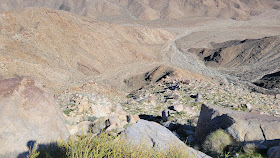Distance: 6.7 miles round trip on trail and cross country
Summit Elevation: 3960'
Prominence: 760'
Elevation Gain: 3300'
Elevation Gain (in Empire State Buildings): 2.6
Round trip time: 6 hours 45 minutes
Recommended water: 88 oz.
Parking/Fees: Free at Borrego Springs Road and Henderson Canyon Road
Difficulty: Strenuous
This was my second summit of Indianhead, a desert classic in Borrego Springs. My first trip was in 2013 following DPS route B, up Palm Canyon then back along the southwest ridge. This time I tried the north ridge. I drove to the intersection of Borrego Springs and Henderson Canyon, then followed the dirt road past the Jeep statue as far north as it went. From the turnaronud, the summit wasn't visible. I followed a use trail up a wash toward Henderson Canyon. It was sandy and flat as I made my way north. When the trail faded, I continued until I reached the alluvial fan from Henderson Canyon. Approaching the main gully, I noticed some bones of a bighorn scattered around. A brief search revealed an intact skull, a spine, and a couple of legs with flesh still clinging above the hoof. The kill didn't look recent. Just right of the gully, I started climbing in the shade of the mountain. The ground was littered with large boulders, low vegetation, and a surprising amount of grass. The north side must retain water long enough for the slopes to be grassy instead of barren like the south side. This helped with traction as it grew increasingly steep.
Indianhead had mutiple sub-ridges extending north. Some were more rugged than others. The route crossed some of the minor ridges to avoid the worst terrain. There was a lot of low level scrambling, but only a couple of moves I'd consider class 3. The slope continued to get steeper near the top and some of the boulders grew to the size of shipping containers. At the top of the ridge, I only had a short walk to the summit. Multiple registers filled a plastic container. I signed the newest one, the previous entry from March. After taking some photos/videos, I headed for the south summit, a prow jutting into space. I had not visited it on my first trip. A faint use trail traced the bottom of the angled slabs and it was easy to get to the high point. It had a dramatic precipice and view. I returned to the main summit for food, then packed up and started down. After navigating the steep slopes down, I was about a mile from the truck when a rock in the flat wash broke loose from the sand and dropped me. I hyperextended my right thumb when I hit, leaving some swelling and a pretty purple ring around it. Bad luck on the mellowest part of the hike. While there is no easy way to the top of Indianhead, the north ridge seemed easier than DPS route B. Part of that impression might be due to having more experience now, but the grass on the north side really helps with traction. The north ridge also provides shade in the morning, so it requires less water. Indianhead remains one of my favorite desert peaks.
See Also:
Indianhead via DPS Route B
Indian via East Ridge




















































